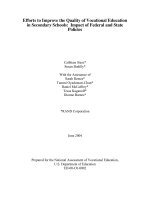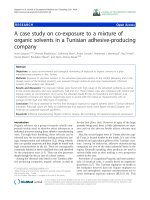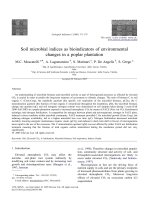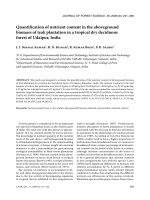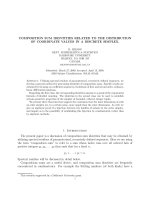Soil infiltration responds to post-harvesting prescribed burning of Acacia plantation in a headwater mountain
Bạn đang xem bản rút gọn của tài liệu. Xem và tải ngay bản đầy đủ của tài liệu tại đây (745.91 KB, 12 trang )
Management of Forest Resources and Environment
SOIL INFILTRATION RESPONDS TO POST-HARVESTING
PRESCRIBED BURNING OF ACACIA PLANTATION
IN A HEADWATER MOUNTAIN
Bui Xuan Dung1, Kieu Thuy Quynh1
1
Vietnam National University of Forestry
SUMMARY
To determine the responses of soil infiltration characteristics to post-harvesting prescribed burning of Acacia
plantation forest in a headwater mountain of Vietnam. The field experiment for infiltration measurement was
established at different stages (including 5-year-old Acacia forest, after harvesting, after prescribed burning
and planting new young forest) from August to October 2020. A number of affecting factors were determined,
including vegetation characteristics and soil physical characteristics of Acacia plantation. The main findings
included: (1) Total time for one process from harvesting to planting new forest was nearly 30 days. Both
factors of vegetation and soil properties changed during four stages; (2) The infiltration rate of all locations in
all stages followed the trend of decreasing after harvesting, burning, and recovering after planting new forest.
The infiltration accumulation, initial rate, and stable rate was highest in 5-year-old Acacia plantation (525.8
mm, 20.2 mm/min and 2.9 mm/min, respectively), and then decreased continuously to lowest position after
burning (211.1 mm, 10.1 mm/min, 1.2 mm/min, respectively) and recovered when new forest was planted. The
factors affect to soil initial infiltration were understory cover, dry bulk density and porosity. Besides, the
factors influence stable rate were understory cover, canopy cover, dry bulk density, percentage of silt and clay
in soil; (3) These findings suggest that improving soil quality and temporal infiltration rate are necessary
during-after forest harvesting and soil treatment periods of Acacia plantation in headwater mountainous areas.
Keywords: Acacia plantation, after harvesting, headwater, infiltration, prescribed burning.
1. INTRODUCTION
Soil infiltration is a process involving
where water soaks into or is absorbed by the
soil, which occurs in both soil science and
watershed management field (Partten, 1908;
Charles, 1932 and Horton, 1933). Soil
infiltration is one of the important hydrological
components and processes in water balance
(Horton, 1993). The rate of infiltration is
transferred through the soil depends heavily on
surface
conditions
especially
forest
environment which has different surface
conditions can exist and have different effects
on infiltration (Robichaud, 2000). Soil
permeability affects to the generation of
overland flows and groundwater flows. When
the infiltration rate is fast, the dominant
underground flow will reduce the risk of soil
erosion. In contrast, slow and poor water
permeability leading to big surface runoff can
cause landslides and floods (Dien, 2006 and
Hai, 1993). Therefore, in order to effectively
manage soil and water resources, maintaining
the infiltration of the soil is very important
(Dung, 2016).
Prescribed burning is known as a treatment
method used to manage vegetation after
harvesting. The reasons why the forestland
owners usually use prescribed burning is that it
is a relatively inexpensive and effective
vegetation-conversion technique to reduce
accumulated fuel and alteration of fuel
continuity (Baeza et al., 2002 and Fernandez et
al, 2008). Prescription burning can affect the
potential of forest land production by reducing
water retention, rapid erosion, and reduced soil
permeability and fertility (Wells et al., 1979).
Besides, fire can be reducing the infiltration
rate and increase soil erosion because of
destroying soil-protecting vegetation and litter
leading to decrease porosity as a result of
organic matter loss and the associated
breakdown in soil structure (Hendricks et al.,
1994 and Wahlenburget et al., 1939). Annual
prescribed burning did reduce the infiltration
capacity by 38 percent while removed litter by
raking only caused 18 percent (Arend, 1941).
When the water permeability of the soil
decreases due to burning will lead to
unpredictable consequences. After the fire, the
soil wettability that was both low- and highseverity burns approached that of unburned
soil (Robichaud, 2000).
Luong Son is an Eastern district of Hoa
Binh province with a large area of planted
forests in the head watershed. Acacia species
account for the majority of the plantation area
of 92% and are the main source of income for
JOURNAL OF FORESTRY SCIENCE AND TECHNOLOGY NO. 11 (2021)
47
Management of Forest Resources and Environment
local people due to suitable natural conditions,
rapid growth and short rotation (Dung and
Thanh, 2021). After harvesting, vegetation is
cleared, then burned, even branches, and
leaves after exploitation are also burned before
afforestation. (Duong and Trieu, 2007; Dung
and Thanh, 2021). In Vietnam, studies on soil
water permeability due to soil treatment before
reforestation are limited. No more studies have
been implemented on the soil permeability
after burning vegetative residuals after
harvesting. Therefore, the study titled “Soil
infiltration responds to post-harvesting
prescribed burning of acacia plantation in a
headwater mountain” was conducted. The
majority of studies thus, focused on comparing
the infiltration rate of acacia plantation at
different ages and natural conditions. Based on
the research results, the comparison of the
infiltration of soil before and after burning of
the vegetation is determined, which is the basis
to propose solutions to manage the sustainable
Acacia plantation model in headwater
mountain.
2. RESEARCH MOTHODOLOGY
2.1. Study site
Figure 1. Map of study site
Luong Son district is located in the midland
region - the transition area between the delta
and the mountains, so the terrain is very
diverse (Fig. 1). Low mountainous terrain with
floor height of about 200 – 400 m is formed by
magmatic rocks, limestone and terrigenous
sediments, with a dense network of rivers and
streams. The climate in Luong Son is a
monsoon tropical climate, characterized by
distinct seasons. The rainy season starts from
April to October, the rainfall accounts for 91%
48
of the annual rainfall. Annual average rainfall
is 1,520.7 – 2,255.6 mm, rainfall mainly from
May to October, the remaining months of the
year rainfall are negligible. The average
temperature is 22.9 – 23.3°C. The hottest
month is 35°C (June & July). The coldest
month is 8°C (January).
The total forest land area is 18,733.19 ha,
accounting for 49.68% of the natural area. The
natural forests of the district are quite diverse
and rich with many kinds of precious woods.
JOURNAL OF FORESTRY SCIENCE AND TECHNOLOGY NO. 11 (2021)
Management of Forest Resources and Environment
But due to human impacts, forests have lost
too much and replaced them as secondary
forests. Forest area is distributed in all
communes in the district.
2.2. Method
2.2.1. Soil infiltration measurement
Soil infiltration is measured in 4 stages:
mature-age forest, after harvesting (before
burning vegetation), after burning vegetation
and soil preparing for new Acacia planting
cycle. 3 selected points were measured the
infiltration at the height of the top hill, middle
hill and the downhill. The coordination of
these
locations
were
20.841667N,
105.451392E (Fig. 2).
Figure 2. Contour map of study site
Double-ring infiltrometer was used to
measure the temporal infiltration characteristics
of different condition covers. Ring was 20 cm
diameter and made from steel with sharpened
bottom edges. A big hammer was used to place
rings into the soil with a depth of 5 cm. Grass
was cut to near soil level. In generally, the
water level was kept at or above 5 cm depth
(plug a sharp nail into center of the inner ring,
then keep the nail 5 cm above the soil).
Cylinder was used to pour the water slowly into
the ring of 5 cm initial water above the topsoil,
with 10 cm nail (Fig. 3).
Figure 3. Double-ring infiltrometer
JOURNAL OF FORESTRY SCIENCE AND TECHNOLOGY NO. 11 (2021)
49
Management of Forest Resources and Environment
First step is driving the ring into the ground
up to the three-inch mark. The best way to do
this is to pound a small block of wood laying
across the ring with a mallet. Firm the soil
around the inside of the ring. Next, put a nail
in to the ground of the center of the ring, the
nail has the length of 5 cm after plugged into
the soil. In general, the water level was kept at
or above 5 cm depth (Fig. 3). Finally, using a
cylinder to pour the water slowly into the ring
of 5 cm initial water above the topsoil, with 10
cm nail and record in each minute during 120
minutes about how many water infiltrates as
the following table 1.
Table 1. Soil infiltration data collection
Date:
Implementer:
Location:
Weather:
Initial water level: 5cm
Diameter of ring:
No.
Minute
∆H (additional water) (ml)
1
0
2
1
…
…
121
120
2.2.2. Vegetation characteristics and soil
properties
There are 5 characteristics of vegetation
was investigated: Density of tree, vegetation
cover, canopy cover, BDH and total height.
Canopy Cover Free was used to determine
understory vegetation cover. The equipment
and software including GPS, GLAMA,
Caliper, Blume Leiss, measuring tape were
used to determine slope, coordinate system
and grow data (Table 2).
At each infiltration measurement point, take
Parameters
soil samples to compare the differences in the
criteria: Particle density, Dry bulk density,
Porosity, soil moisture and soil texture –
factors affecting soil infiltrations. Total 36 soil
samples were taken at 3 locations (top hill,
middle hill and downhill) in 3 depth levels (0 5 cm, 25 - 30 cm and 55 – 60 cm equivalent to
A and B layer, respectively) at 4 stages
(mature age, after harvesting, after burning and
plating new forest). Vegetation and soil
characteristics at the study site was
summarized in Table 2.
Table 2. Vegetation and soil characteristics at the study site
Stage 1:
Stage 2:
Stage 3:
Before harvesting
After harvesting
After burning
Stage 4:
Young forest
Density (trees/ha)
Understory vegetation
cover (%)
820
0
0
1600
82
0
0
62
Canopy cover (%)
83.5
0
0
0
DBH (cm)
41.68
0
0
Insignificant
Height (m)
14.56
0
0
0.6
27
27
27
27
Elevation (m)
130
130
130
130
Soil depth (cm)
161
161
159
160
South-West
South-West
South-West
South-West
Slope (o)
Aspect
50
JOURNAL OF FORESTRY SCIENCE AND TECHNOLOGY NO. 11 (2021)
Management of Forest Resources and Environment
2.2.3. Data analysis
Data was analyzed by Microsoft Excel, IBM
SPSS Statistics 23 and R-studio to determine
responses of soil infiltration characteristics and
impact factors at all location of different stages
of Acacia plantation treatments.
3. RESULTS AND DISCUSSION
3.1. Infiltration rate at different stages
Figure 4. Box plot of infiltration rate at different stages of treatment
The temporary soil infiltration fluctuated
during 4 stages. In general, the soil infiltration
on top hill, middle hill and downhill did not
change too much, but there is a clear
difference among these stages (Fig. 4).
In general, the infiltration rule at all points
was the same, quickly infiltration in the first
minute and then gradually decreasing until the
stable rate (Fig. 5). The rules over time change
due to the harvesting activities, processing of
prescribed burning and soil preparation before
planting young forest. Infiltration rate of 5year-old Acacia plantation before harvesting
was highest at 22.6 mm/min at the first minute
in top hill. At the middle hill and downhill, the
infiltration rate was 20.2 and 17.7 mm/min,
respectively (Fig. 5a). In stage 2, after
harvesting, the average total infiltration
accumulation reduced significantly by nearly
300 mm. The permeation rate was most
noticeable at stage 3, after burning of the
vegetation. At this stage, the initial infiltration
rate at the downhill was lowest at 7.6 mm/min,
halved that of the stage 1 at the site (Fig. 5b).
The infiltration rate in stage 3 ranged from 1.1
to 5.2 mm/min and the stable action rate was
also lowest (Fig. 5c). In stage 4 after preparing
the soil for young forest plantations and
impacted by the excavation and tilling, the
initial infiltration rate recovered to 19
mm/min. The infiltration rate for the rest of the
time ranged from 1.4 to 18.2 mm/min and the
average rate increased by 0.6 mm/min
compared to stage 3 (Fig. 5d).
JOURNAL OF FORESTRY SCIENCE AND TECHNOLOGY NO. 11 (2021)
51
Management of Forest Resources and Environment
Figure 5. Infiltration rate in different stages: a) mature-age forest; b) After harvesting;
c) After prescribed burning; d) Planting new forest
The average infiltration rate in all 4 stages
follows the same rule, the high initial rate
would gradually decrease and reached a stable
52
rate from the 110th minute to the end of the
period. The initial infiltration rate of 5-yearold Acacia forest was highest followed by that
JOURNAL OF FORESTRY SCIENCE AND TECHNOLOGY NO. 11 (2021)
Management of Forest Resources and Environment
of young forest. The initial rate of forest land
in stage 3, after prescribed burning was the
lowest, and that of stage 2 was the second
lowest one. The stable rate of the 5-year-old
Acacia forest was 3 mm/min which doubled
that of others. Stable rate of the 3 remaining
stages ranged from 1.2 to 1.8 mm/min. The
highlight of the figure was that the infiltration
rate for the first 10 minutes of stage 4 was
higher than that of stage 1, but during the
period the infiltration rate of the 5-year-old
Acacia forest was still the highest (Figs. 5, 6
and 8).
Figure 6. Box plot of initial and stable rate in different stages (mm/min)
The initial infiltration rate was followed the
rule: the initial rate of 5-year-old Acacia forest
land was highest, and then decreased gradually
in the stage of harvesting and dropped to the
lowest position in stage 3 - after burning. In
stage 4, infiltration rate recovered due to
tillage and soil preparation for new planting
process (Figs. 6 and 8).
The average initial infiltration rate of 5year-old Acacia forest was 20.2 mm/min, the
maximum rate was 22.6 mm/min, and the
minimum one was 17.7 mm/min. The
infiltration rate decreased over time. In stage
2, the initial rate was 15.3 mm/min on average.
The average initial infiltration rate for stage 3
continued to decrease sharply to 10.1 mm/min.
The minimum infiltration rate was 7.6
mm/min at stage 3. The p value when
comparing the initial rate of stage 3 with the
two before and after stages by T test was 0.01
which less than 0.05, showing the difference
among the infiltration rate of each stage was
statistic significant. The potential reason could
be prescribed burning that cause soil crust and
compaction. In stage 4, the initial infiltration
rate gradually increased roughly equal to that
of the Acacia forest before harvesting (Figs. 6
and 8).
Similar to the initial rate, the stable rate also
followed the rule of high infiltration rate in 5year-old
Acacia
plantation,
gradually
decreased after harvesting, and then dropped
to the lowest point after prescribed burning
and increased again when planting young
forests (Figs. 6 and 8). The average stable rate
of 5-year-old Acacia forest was the highest at
2.9 mm/min. The maximum average
infiltration rate was 3.1 mm/min and the
minimum one was 2.5 mm/min. After
harvesting, the average stable rate was 1.7
mm/min, decreasing by 1.2 mm compared to
the previous stage. At stage 3, the stable rate
dropped sharply to 1.1 mm/min, the lowest
rate in the process. After preparing soil for the
next crop, the stable rate of the forest soil
increased significantly to 1.8 mm/min on
average (Figs. 6 and 8).
JOURNAL OF FORESTRY SCIENCE AND TECHNOLOGY NO. 11 (2021)
53
Management of Forest Resources and Environment
3.2. Total infiltration accumulation in 1 hour
Total infiltration in 1 hour (mm)
600
500
Top hill
Down hill
Midle
Middle
hillhill
Average
400
300
200
100
0
Stage 1
Stage 2
Stage 3
Stage 4
Figure 7. The total infiltration accumulation at different stages
In general, the total infiltration volume per
hour of 5-year-old Acacia forest was highest,
and then decreased after harvesting and
dropped to the lowest point after burning. This
data increased again at stage 4 after planting
young forest (Figs. 7 and 8).
The 1-hour total infiltration accumulation
of 5-year-old Acacia plantation was highest at
525.8 mm an average. During this period, the
highest accumulation was in downhill (538.8
mm) which was followed by that in middle hill
at 530.6 mm. In the period after clear cutting,
the total infiltration in 1 hour decreased by 1/3
compared with the previous period (at 304.9
mm on average). The middle hill position had
the least total amount of infiltration
accumulation
at
273.9
mm.
Total
accumulation continued to decrease and
bottomed out in stage 3 at 211.1 mm on
average. At this stage, the total infiltration
accumulation in 1 hour at to mid-hill was
highest at 243.1 mm, which higher than that in
downhill by 43.1 mm. The middle hill had the
least total permeability at 190.2 mm. In stage
4, the total permeability in 1 hour doubled that
in the previous period to reach 407.5 mm (Fig.
7 and Fig. 8).
Figure 8. Mean infiltration characteristics summary at different stages of forest management
54
JOURNAL OF FORESTRY SCIENCE AND TECHNOLOGY NO. 11 (2021)
Management of Forest Resources and Environment
Figure 9. Total infiltration in 1 hour of other studies (Linh et al., 2019; Hoa and Dung, 2020)
Compared to the total water infiltrated in
one hour reported by other researches at
different locations, the amount of water in the
Acacia ranged from 59 mm/hr to 526 mm/hr.
In previous studies, the hourly infiltration rate
in the area with 5-year-old Acacia plantation
was 310 mm/hr. The relative high infiltration
rate per hour of the research might be
explained by quite high proportion of
understory vegetation cover and porosity. In
addition, previous studies have proved that the
positive relation between porosity and
understory vegetation with infiltration
capacity, therefore, it also follows the trend to
negative correlation between infiltration
2.5
0 20
60
20
1.5
capacity and possibility of generating overland
flow (Hiraoka at al., 2010). The average total
infiltration rate in 1 hour of after burning in
2020 is 211 mm, nearly the same with this
stage in Acacia plantation in Luong Son in
2019 (Hoa and Dung, 2020). Total infiltration
in young forest in 2020 was 408 mm higher
than that in 1-year-old Acacia forest in 2019
and 2018 by 181 and 216 mm, respectively.
Regarding high amounts of water infiltrated in
one hour, the soil under different ages of
Acacia trees are expected to reduce the relative
amount of saturated overland flow (Fig. 9).
3.3. Correlation of infiltration rate with
vegetation and soil factors
Initial.rate
0.53
0.40
15
0.82
2.5
10
0.74
1
Stable.rate
0.89
0.69
0.73
0.25
1.5
0.79
3
6
60
Understory .cov er
0 20
5
Canopy .cov er
7
Litter
0
40
4
80
0.69
0 20
60
2
(1) Initial and Stable rate
(2) Initial rate and Understory
cover
(3) Initial rate and Canopy cover
(4) Initial rate and Litter
(5) Stable rate and Understory
cover
(6) Stable rate and Canopy
cover
(7) Stable rate and Litter
10
15
20
0 20
60
0
40
80
Figure 10. Correlation between initial and stable rate with vegetation factors
JOURNAL OF FORESTRY SCIENCE AND TECHNOLOGY NO. 11 (2021)
55
Management of Forest Resources and Environment
Initial rate and stable rate had positive
relationship with vegetation factors such as
understory cover, canopy cover and litter.
Initial rate had a strong positive relationship
with understory vegetation with high
correlation coefficient (i.e., R = 0.82) (Fig.
10). Initial rate increases when the understory
vegetation increases. Meanwhile, the stable
infiltration rate was strongly correlated with
both understory cover and canopy cover with
R was 0.79 and 0.89, respectively. The stable
rate had medium correlation with the litter (R
2.5
2.5
2.7
20
24
20
1.5
= 0.69) (Fig. 10). It can be easily seen that the
infiltration rate is highly dependent on the
understory cover and canopy cover (Hiraoka et
al., 2010). When the rainfall comes, the
canopy reduces the force of free water falling,
makes soil less fragmented, and surface
runoff is reduced. In addition, the understory
cover increases soil infiltration by creating
many holes in land by the root system. This is
also a factor to make recommendations to
increase permeability of pure Acacia
plantation forest land.
Initial.rate
-0.83
-0.64
0.77
-0.06
10
0.74
-0.82
1.5
2.5
(1) Initial and Stable rate
Stable.rate
1
-0.35
0.69
(2) Initial rate and Dry bulk density
0.25
Dry.bulk.density
0.54
7
2.7
-0.34
-0.15
(5) Initial rate and Moisture
(6) Stable rate and Dry bulk density
-0.02
60
3
Porosity
4
-0.06
52
8
(7) Stable rate and Particle density
(8) Stable rate and Porosity
(9) Stable rate and Moisture
Moisture
5
9
20
24
(4) Initial rate and Porosity
Partical.density
56
2.5
-0.59
1.05
2
1.25
(3) Initial rate and Particle density
6
10
20
1.05
1.25
52
56
60
Figure 11. Correlation between initial and stable rate with soil factors
For soil properties, the initial infiltration
rate was proportional to porosity, inversely
proportional to the remaining factors such as
dry bulk density, particle density, and soil
moisture (Fig. 11). Meanwhile, the stable rate
was inversely proportional to the dry bulk
density and particle density, proportional to
the porosity and moisture. Initial infiltration
rate had a strong correlation to porosity with R
equaled 0.77. When the porosity was high, the
pores in the soil were large from which the
initial rate was higher. Both the initial and
stable rates were inversely proportional to the
56
dry bulk density with R of -0.83 and -0.82,
respectively. Both the initial and stable rate did
not correlate much with soil moisture (Fig. 11).
4. CONCLUSION
The process from mature age of plantation
for harvesting to planting new forest cycle
takes 25 to 35 days, averaged to 30 days at the
study site. There are 4 stages including 5-yearold Acacia plantation, after harvesting, after
prescribed burning and planting new forest
was evaluated. Infiltration rate varied among
the stages. Infiltration rate of 5-year-old
Acacia plantation was highest, next decreased
JOURNAL OF FORESTRY SCIENCE AND TECHNOLOGY NO. 11 (2021)
Management of Forest Resources and Environment
after harvesting and dropped to the lowest
position in stage 3 – after harvesting and then
recovered after planting new forest. The total
infiltration accumulation in four stages was
868.9 mm, 466.8 mm, 319.1 mm and 627.7
mm, respectively. Total infiltration for 1 hour
was also followed the trend and the value was
525.8 mm/hr, 304.9 mm/hr, 211.1 mm/hr and
407.5 mm/hr, respectively. The initial rate of
mature age plantation was 20.0 mm/min, then
decreased to 15.3 mm/min in stage 2, that
figure for stage 3 was 10.1 mm/min and then
recovered to 19.3 mm/min. The stable rate of
four stages was 2.9 mm/min, 1.7 mm/min, 1.2
mm/min and 1.8 mm/min, respectively.
Infiltration rate of the soil follows the trend of
the highest value at the beginning and
decreases over time. Time to reach the stable
rate of the type of oscillation ranges from 110th
to 120th minute. Both initial and stable rate
have positive relationship with understory
vegetation cover. Initial infiltration rate of soil
has a strong relationship with understory
vegetation (R = 0.82), porosity (R = 0.77) and
dry bulk density (R = -0.83), but do not have
significant relationship with canopy cover and
soil moisture. While stable rate has a strong
relationship with understory vegetation (R =
0.79), canopy cover (R = 0.89), dry bulk
density (R = -0.82), moderate relationship with
litter cover (R = 0.69).
REFERENCES
1. Arend, J. L. 1941. Infiltration Rates of Forest
Soils in the Missouri Ozarks as Affected by Woods
Burning and Litter Removal. Journal of Forestry (39) pp
726 – 728.
2. Baeza J, De Luis M, Raventos J, Escarre A. 2002.
Factors influencing fire behavior in shrub lands of
different stand ages and the implications for using
prescribed burning to reduce wildfire risk. Journal of
Environmental Management (65) pp 199 – 208.
3. Charles H. Lee. 1932. On absorption and
transpiration. Transaction, American Geophysical
Union, pp 288 – 298.
4. Dien P.V. 2006. Research on water holding
capacity in some types of vegetation cover in Hoa Binh
Hydropower Plant. Doctorate in Agriculture, Hanoi
National University of Forestry.
5. Dung B.X. 2016. Soil infiltration characteristics
under some types of land use in Luot mountain, Xuan
Mai, Hanoi. Journal of Forestry science and technology,
No. 4, pp 47 – 58.
6. Dung B.X., Thanh DT. 2021. Runoff and Soil
Erosion Response to Clear Cutting Period of Acacia
Plantation in A Headwater Mountain of Vietnam.
Applied Research in Science and Technology, Vol. 01
No. 01, (12-25).
7. Duong NQ, Trieu DT. 2007. Impact of vegetation
treatment, soil preparation and fertilizer application on
the growth of some Acacia species grown in Vietnam.
Journal of Agriculture and Rural Development, (18) pp
1 – 8.
8. Fernandez C., Vega J.A., Fonturbel T., Jimenez E.
and Perez J.R. 2008. Immediate effects of prescribed
burning, chopping and clearing on runoff, infiltration
and erosion in a shrub land area in Galicia (NW Spain).
Land Degradation and Development (19) pp 502 – 515.
9. Hai, V.D. 1993. Effect of forests on water
regulation and soil erosion control. PhD thesis on
agricultural science. Forest Science Institute of
Vietnam, Hanoi.
10. Hendricks, B. A., and Johnson J.M. 1944. Effect
of fire on steep mountain slopes in central Arizona.
Journal of Forestry (42) pp 568 - 571.
11. Hiraoka M, Onda Y, Kato H, Mizugaki S, Gomi
T, Nanko K. 2010. Effect of understory vegetation on
infiltration capacity in Japanese cypress plantation.
Journal of Japanese Forest, 92 (3): 145-150. DOI:
10.4005/jjfs.92.145
12. Hoa D.T, Dung B.X, 2020. Temporal infiltration
characteristics of soil at different ages of Acacia
plantation forest in a headwater of Hoa Binh, Vietnam.
Journal of forest science and technology, 10: 38-47.
13. Linh P.T, Dung B.X, Bao T.Q. 2019. Infiltration
characteristics of soil under cinnamon and acacia
plantation forest in headwater of Viet Nam. Vietnam
Journal of Forest Science, 4: 64-74 .
14. Patten and Gallagher. 1908. Absorption of
vapors and gases by soils. U.S. Department of
Agriculture.
15. Robichaud P.R. 2000. Fire effects on infiltration
rates after prescribed fire in Northern Rocky Mountain
forests, USA. Journal of Hydrology, pp 220 – 229.
16. Horton R.E. 1933. The role of water infiltration
in the hydrologic cycle. Transaction, American
Geophysical Union, 14(1) 466.
17. Wahlenburg W.G., Green S.W., and Reed H.R.
1939. Effect of fire and cattle grazing on longleaf pine
land as studied at McNeill, Mississippi. U.S.
Department of Agriculture and Technology.
18. Wells C.G., Campbell R.E., DeBano L.F., Lewis
C.E., Fredricksen R.L., Franklin E.C., Froelich R.C.,
and Dunn P.H. 1979. Effects of Fire on Soil. U.S. Forest
Service General Technical Report (7) pp 34.
JOURNAL OF FORESTRY SCIENCE AND TECHNOLOGY NO. 11 (2021)
57
Management of Forest Resources and Environment
TÍNH THẤM NƯỚC CỦA ĐẤT PHẢN ỨNG VỚI CÁC GIAI ĐOẠN XỬ LÝ
THỰC BÌ SAU KHAI THÁC RỪNG TRỒNG KEO THUẦN LOÀI
Ở VÙNG ĐẦU NGUỒN
Bùi Xuân Dũng1, Kiều Thúy Quỳnh1
1
Trường Đại học Lâm nghiệp
TÓM TẮT
Để xác định các phản ứng của đặc điểm thấm nước đối với việc đốt xử lý thực bì sau khai thác rừng trồng Keo
thuần loài ở vùng núi đầu nguồn của Việt Nam. Thí nghiệm đo tốc độ thấm nước của đất đã được thực hiện
ngoài thực địa ở các giai đoạn khác nhau (bao gồm rừng keo 5 năm tuổi, sau khai thác, đốt xử lý thực bì và
trồng rừng non mới) từ tháng 8 đến tháng 10 năm 2020. Một số yếu tố ảnh hưởng đồng thời đã được xác định
gồm đặc điểm thảm thực vật và tính chất vật lý của đất dưới rừng trồng Keo. Các kết quả chính bao gồm: (1)
Tổng thời gian cho một quá trình từ khai thác đến trồng rừng mới là gần 30 ngày. Cả hai yếu tố thảm thực vật
và đặc tính đất đều thay đổi trong bốn giai đoạn; (2) Tốc độ thấm nước của đất ở tất cả các vị trí trong tất cả
các giai đoạn tuân theo quy luật là giảm dần sau khi khai thác, đốt xử lý thực bì và phục hồi trở lại sau khi
trồng rừng mới. Lượng nước thấm gồm lượng nước thấm trong 1 giờ, tốc độ ban đầu và tốc độ thấm ổn định
cao nhất ở rừng trồng Keo 5 năm tuổi (tương ứng là 525,8 mm/giờ, 20,2 mm/phút và 2,9 mm/phút), sau đó
giảm liên tục xuống giá trí thấp nhất ở giai đoạn sau khi đốt (211,1 mm/giờ, 10,1 mm/phút và 1,2 mm/phút
tương ứng) và phục hồi khi rừng mới được trồng. Các yếu tố ảnh hưởng đến đặc điểm thẩm nước ban đầu của
đất là độ che phủ của thảm tươi, thảm khơ và độ xốp. Bên cạnh đó, các yếu tố ảnh hưởng đến tốc độ thấm ổn
định là độ che phủ, độ tàn che, dung trọng đất, tỷ lệ cấp hạt thịt và sét trong đất; (3) Kết quả nghiên cứu đã chỉ
ra rằng việc bảo vệ chất lượng và tính thấm nước của đất là rất cần thiết trong suốt giai đoạn khai thác và xử lý
thực bì rừng trồng Keo thuần lồi ở các vùng đầu nguồn.
Từ khóa: đốt xử lý thực bì, rừng trồng Keo thuần loài, sau khai thác rừng, thấm nước của đất, vùng
đầu nguồn.
Received
Revised
Accepted
58
: 02/7/2021
: 04/8/2021
: 12/8/2021
JOURNAL OF FORESTRY SCIENCE AND TECHNOLOGY NO. 11 (2021)
